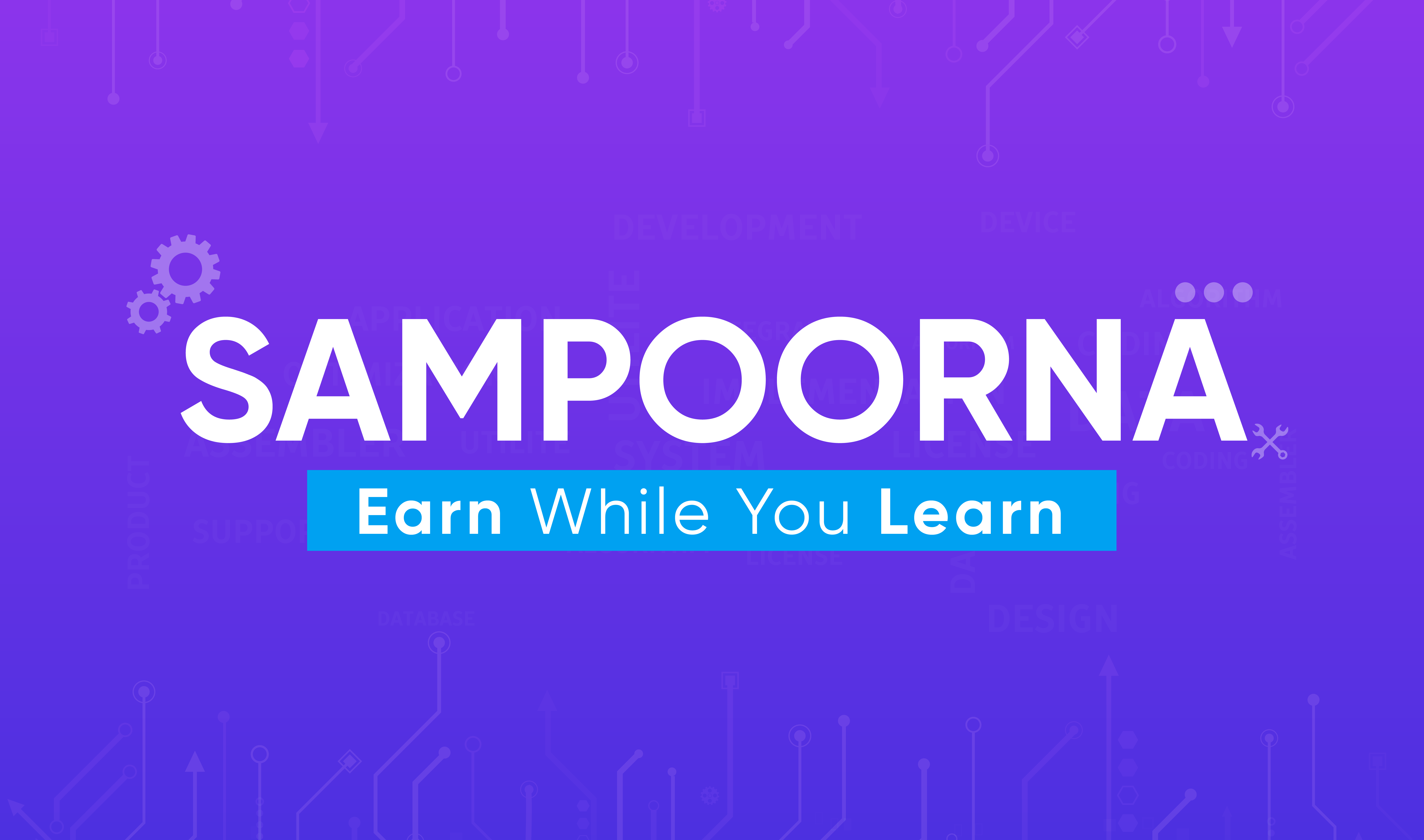Why should you do this course?

Key Highlights
 1200++ Problems
1200++ Problems
 20-30k per month earning while you study
20-30k per month earning while you study
 15/18 Months Duration
15/18 Months Duration
 Placement assistance
Placement assistance
 Syllabus
Syllabus
-
Welcome aboard
Welcome to the course -
Flowcharts and Psuedocode
This helps you to understand how to convert logic and write it in the form of diagrammatic and textual way. -
Basics of Programming
For any language the first and the most important thing to learn is the syntax, variables, loops, and conditionals. In this section, we will cover how to convert our logic to C++ Code. -
Operators in C++
To help you understand different types of operators such as Arithmetic, Compund assignment, Bitwise, and Logical operators. -
Functions
In this section, you will learn to write code in a modular way to help you reuse the code in different C++ files and make it more readable and organized. -
Recursion Introduction
"Inorder to understand Recursion we must understand Recursion, so this is what is focussed here i.e. write codes using Recursion.
It is used in Dynamic Programming and as well as in data structure such as Trees, Graphs, and Heap etc." -
Deep Diving into recursion
In this section, we will start exploring how to form recurrence relations using problem statements and mainly discussing recursion on arrays and strings. -
Recursion on Subsets
In this section, we will understand how to solve algorithms such as phone search and advanced concept of Knapsack that is mostly asked in Interviews. -
Backtracking
It is the most important concept to understand in Recursion and it is thoroughly checked in Interviews and Technical Rounds. If one has to master recursion they need to master backtracking. -
Time and Space Complexity
It helps us to compare the algorithms on the basis of Time and Space it takes to run the code and help us to master how to write codes by considering constraints of the problem. -
Object Oriented Programming
One of the most important topic to build data structures, this is not only used in every data structure but also help us to understand how to associate the real world with programming language. -
Linked List
In this topic we learn how to store data in a non-contiguous manner and we understand how the Linked List can work in a better time complexity that other data structures in some operations. -
Stack
It follows the principle of Last In and First Out, although this data structure can be easily understood but the concept of LIFO can be used to solve some typical problems such as Histogram Area, Stock Span, and Balanced Parantheses etc. -
Queues
This data structure works just like a normal queue does and it is mainly used as a helping data structure in Trees and Graphs. -
Binary Trees and Binary Search Trees
In this data structure, we learn how to store data in a hierarchical format. It is one of the most important topic from Interview point of view and questions from this topic is frequently asked in companies such as Amazon, Microsoft, Flipkart and Google etc. -
Heap
This data structures helps you to understand how the infinite stream of data coming can be accessed to fetch the useful information, for example, find the most sold products on any website? -
Hashmap
It helps us to understand how we can store, update and delete the data in constant time. It is majorly used in Dynamic Programming and Graphs to help us make the time complexities of the algorithms better. -
Graphs
"The most popular data structures in companies like Direct-i, Google, and Arcesium etc.
It is usually considered tough because of the dependency on other data strucutres such as queue, hashmaps, sets, and heap etc. but once you get a taste of how to apply these things together it will make you a better programmer. -
Tries
It helps us to search in constant time and incase you want to use auto suggestions features of Amazon, Flipkart or other sites search bar this is the solution.
Many problems such as Maximum-Xor, and Maximum Sum etc. uses tries to help improve complexity of the problem. -
One Dimensional Dynamic Programming
We learn how we can improve the time complexities of Recursive algorithms drastically using concepts like Top Down approach. Also we convert out Top down approach to bottom up approach using the recurrence relation and DP concept, it's exactly what is required for the master DP. -
Two Dimensional Dynamic Programming
The most important concepts of DP are Knapsack, Optimal Game strategy, and solving string problems using 2D storage there by improving their complexities multiple folds. -
Greedy Algorithms
This is where you learn how being greedy can benefit you to solve certain problems in a faster way. The main point of focus here is to understand where we can apply Greedy over Dynamic Programming. -
Top Tech Company Questions
Practise from the most asked questions in companies such as Amazon, Facebook, Microsoft, LinkedIn, and Google etc. Become the programmer to crack any of your dream company. -
Google, Amazon, GoJek, Flipkart, Uber, Amex
Interview mantras
This will give you an idea of how you should prepare yourself for the final interviews and prepare yourself for everything that you may face during the placement process of any company.
-
Master HTML
In this you will learn how to create the structure and the template of the webpages and websites. -
Mastering CSS
In this you will learn how to add styles and make your webpages look stylish and responsive. -
Basics of Programming
For any language the first and the most important thing to learn is the syntax, variables, loops, and conditionals. In this section, we will cover how to convert our logic to Code. -
Mastering JavaScript
In this you will understand how to add the functionality to you HTML and CSS webpage and websites. -
Functions
In this section, you will learn to write code in a modular way to help you reuse the code in different files and make it more readable and organized. -
The Internet
Introducing web and learning about internet,Understanding web and http, learning all about Web vs Internet,Learning about client-server architecture,Understaning frontend and backend. -
What do HTML/CSS/JS do?
Understanding frontend technologies - HTML, CSS, JS -
Setting Up Our Developer Environment
Setting up VS - Code - Installing various extensions( live-server etc) -
Introduction to HTML
First brush with HTML, understaning html and role of html in creating a web page,Writing our first html code,Understanding HTML Boilterplate , HTML-5 syntax and HTML Tree,Looking for documentation on MDN and W3School. -
Learning HTML Tags
Learning heading, paragraph and other useful html tags,Understanding Blocks vs Inline elements,Entity codes, working with anchor tags, various use cases of anchor tags. -
HTML Forms
Taking input from the using various HTML Input Elements and learning all about HTML Forms -
HTML Tables
Creating tables in HTML -
Media
Elements-Image,Audio,Video,iframe
Learning how to work with images, audio, video and iframe elements in HTML. -
HTML Sementic elements
Learning about HTML Sementic Elements(nav, article, section, header, main, footer, aside, figure and figcaption. -
Introduction to CSS
Introducing CSS and understanding the role of CSS,Adding CSS to out HTML Page,Learning all about selectors (Basic + Advanced Selector),Understaning inheritance of various properties and Precedence of selectors in CSS. -
Basic CSS Properties and Box Model
Learning about background-color, font-size, color, border, text-transform, text-decoration etc. Learning about CSS Colors and various Color format (hexadecimal, rgb, rgba and hsl format), Learning about box model in CSS and various box-model properties. Understanding CSS Units. -
Display, Positions and Flexboxes, Media
Queries
Working with layout and changing the normal flow and default layout using display, positions and flexboxes, using Media Queries to create responsive layout. -
Transition, Transform and CSS
Animations
Learning about fun stuff in CSS, adding transition, transform and Animations. -
3D Transform
Creating a 3D rotating card using 3D Transform -
CSS Grids and CSS Variables
Understaing CSS Grids and creating responsive layout using grids, Understanding CSS Variables. -
Introduction to CSS Frameworks
Exploring various CSS frameworks - Bulma, Material UI, Sementic UI, Tailwing CSS, and Bootstrap. -
Bootstrap
Exploring bootstrap and how to add in our project,Learning all about bootstrap grids and creating a responsive layout,Using various bootstrap components - navbar, card, button etc,Exploring bootstrap utilities for css - flex, display, positions, font etc -
Introduction to JS
Introducing JS, Various features - Compile-Interpreted-JIT languages, Dynamically vs Statically Typed JS Engine,Learning primitives in JS(Number, String, Boolean, undefined, null) and strings methods,Learning all about Math object and generating random numbers in given range,Understaning if-else if-elseif-else , Ternary operator, Binary operator, Logical and Bitwise Operators Shortcircuiting using Logical AND and OR operator -
JS Arrays, Nested Arrays
Learning the first data structure - Array, and Various Array methods. -
JS Objects
Learning all about JS Object -
Repeating stuff with Loops
Understanding while, for, forof and forin loops in JS -
Introducing Functions
Learning all about functions and types of function - function expression, arrow function, first class function. -
Function deep dive - Execution
context
Diving deep into the function execution and understanding the execution context -
Scopes, HOF, Closure
Resoving scopes in JS, Learning about HOF and Closures -
Prototypes, Constructor Function and Class
Syntax
Understaning Object inheritance in JS and how prototypes helps to achive it, Understanding Construction function and class Sytax in JS(getter, setter, static methods. -
Async Programming and Web APIs
Asynchrounous Programming - Event Loop, Callback Queue and Web APIs Environment. -
Callback Hell and Promises
Understanding Callback hell and using Promises -
Introduction to DOM Web API
Understanding what DOM is and how to manipulate DOM using JS,Selecting elements in a DOM tree using various selectors,Learning about various DOM properties - innerText, textContent, innerHTML, setAttribute, getAttribute,Travarsing the DOM tree from child to parent and vice-versa,Creating and deleting elements in a DOM tree. -
Events and Event Listener
Diving into the events and how events works -
Event Lifecycle - Bubbling and Capturing,
Event Delegation
Exploring the event life cycle and understanding event bubbeling, Capturing and Event Delegation. -
jQuery
Introduction to JS framework-jQuery, Learning and exploring easy to use APIs provided by jQuery,Exploring various APIs in jQuery - .css(), html(), attr(), first(), last() etc,Learning how add events in jQuery,Creating effects using jQuery- sliding, toggle etc -
Understanding AJAX
Introduction to AJAX, learning what AJAX is and how it is useful in Web Development and SPAs,Comparing traditional Client-Server Model with AJAX Model,Learning about various data exchange format - JSON and XML. -
APIs and Endpoints, Postman
Demystifying the APIs and Endpoints calling the APIs using Postman, understanding Status Code etc.,Learning how to make HTTP request using JS,Learning the native of making AJAX request using XMLHttp request object. -
Fetch
Introducing modern way of making request using fetch web API -
Third Party Libraries - Axios, jQuery
Making request using third party libraries such as Axios and jQuery -
Unix, Git and Github
Exploring Unix environment and basic unix commands,Learning all about VCS and why do we need them,Exploring git in detail and learning how to commit changes, resolve conflicts etc.,Learning all about github. -
Exploring Node.js
Introducing Node.js and Learning all about Node, how its is useful, what we can do using Node etc.,Learning various inbuilt Node modules e.g : http, file-system, path etc.,Sharing code between js files in Node.js. -
File System, Path Modules
Working with file system, Learning how to read and write data into the files - Exploring NPM, installing and uninstalling packages Exploring NPM world and learning how to install packages using NPM and creating projects using NPM,Installing packages locally and globally.
-
Introducing Express
Introducing out Web Framework for creating server,Comparing library and frameworks,Creating our first express app -
Using nodemon
Using nodemon as a tool to restart server automatically. -
All about templating engines
Understanding templating languages and why do we need them -
Configuring express to use EJS
Configuring express to use various templating engine such as EJS,Setting up the views directory,Learning about various ejs tags and their uses,Passing data from server to the templates. -
Conditionals and Loops in EJS,Serving static
assets in Express
Learning how to conditionally render the data in templates and Looping over data inside the templates,Using stylesheets and scripts in our express app as static files -
GET vs POST Request
Introducing GET vs POST request and where do we use them -
Defining POST route,Parsing the request
body
Understanding POST request in detail,Parsing the request body using express body parsing middleware -
All about REST
Learning all about REST architecture and creating REST routes for CRUD app -
Inserting, Update, Deleting with
mongo
Exploring various mongo queries for inserting,deleting, updating data in collections -
Mongo Operators
Learning about mongo operators and their uses for building complex queries -
Introducing Mongoose
Introducing mongoose as ODM,Learning ODM vs ORM,Creating schema using mongoose and using Model to manipulate the data -
Cookies
Learning all about cookies Client Side Storage -
Authentication using bcrypt
Diving into authentication and understanding Authentication vs Authorization,Learning about Cryptographic Hashing Functions,Implementing authentication using Bcrypt from scratch,Implementing Authentication from scratch -
Authentication using Passport.js
Learning about passport.js and adding Authentication using passport,Adding authorisation using middlwares in our app -
Web Security Introduction
Understanding common secuirity issues using and Mongo Injection,Cross site scripting and how to mitigate small attacks,Sanitising payoad before storing the data into the database,Using helmet to prevent various attacks. -
Preparing our app for deployment
Preparing and deploying our app to production enviroment,Connecting our App with cloud database using MongoDB Atlas,Deplyoing and Monitoring our app to Heroku -
Introduction to React.js
Introducing all about React.js and why do we use react how it solves our problem,Exploring new generation js features - destructring, spread, rest parameters, arrow functions etc.,Creating and understanding our first react app. -
Class vs Functional Components State vs
Props
Learning all about React components - Class and Functional components,Handleing state and props in react,Learning how to take input and working with forms in react,React Events -
Learning useState ,useEffect,useRef
Hook
Expolring hooks in react and their uses -
Sending HTTP Request
Sending http request using fetch and axios -
Router - SPAs vs MPAs
Understanding react router - SPAs vs MPAs -
Context API in React
Handling global state with Context in React -
All about react Hooks
More about react Hooks -
MERN Stack Project
Project
-
Welcome aboard
Welcome to the course -
Vector
In this section we will learn about the container vectors which are same as the dynamic arrays with the ability to resize itself automatically.Since its a container it contains various functions which come quite handy while solving the problems. -
Strings
In this section we will learn about strings which is an alternative to character array, String data type helps in handling string easier and faster.With proper understanding of OOPs this concept becomes more clear. -
List
In this section we learn about the STL Lists which is based on the data structure Linked List which store data in a non-contiguous manner. -
Stacks
In this section we learn about the STL stacks which is based on the data structure Stacks which follows the principle of Last In and First Out. -
Queues
In this section we learn about the STL queue which is based on the data structure Queue which follows the principle of First In and First Out.This data structure works just like a normal queue does and it is mainly used as a helping data structure in Trees and Graphs. -
Maps
In this section we will learn about Maps which stores the data in the mapped form of key->value which is implement on the basis of Red Black Trees. -
Priority Queue
In this section we will learn about the STL priority queue which is primarily based on heaps which helps us understand how the infinite stream of data coming can be accessed to fetch the useful information, for example, find the most sold products on any website? -
Set
In this section we will learn about Sets which are internally implemented through BST which store unique elements following a specific order. -
Functions
In this section we will learn about various functions that are there in the STL which help us in solving various problems easily like find,sort etc. -
Policy based Data Structures
In this section we will learn about the some data structures that are not part of the STL but are supported by the gcc.These data structures can be designed for high-performance, flexibility, semantic safety, and conformance to the corresponding containers in std. -
Tries
It helps us to search in constant time and incase you want to use auto suggestions features of Amazon, Flipkart or other sites search bar this is the solution. Many problems such as Maximum-Xor, and Maximum Sum etc. uses tries to help improve complexity of the problem. -
Persistent Tries
In this section we will understand the concept of persistency in tries. -
Binary Search
This is where you learn how being greedy can benefit you to solve certain problems in a faster way.The main point of focus here is to understand where we can apply Greedy over Dynamic Programming. -
Greedy Algorithms
In this section, we will understand how Bitwise operators like AND, OR, XOR, and NOT work on machine code to help and write programs that works faster.This concept is also very useful in Recursion as well as in Dynamic programming and Advanced DSA. -
Bit Manipulation
In this section we will understand about geometry and problems related to them and about convex hull. -
Geometry And Convex Hull
TIn this section we will understand about geometry and problems related to them and about convex hull. -
Hashing
It helps us to understand how we can store, update and delete the data in constant time. It is majorly used in Dynamic Programming and Graphs to help us make the time complexities of the algorithms better. -
Square Root Decomposition/Mo's
Algorithm
In this section we will learn about Sqrt Decomposition which is a method (or a data structure) that allows you to perform some common operations (finding sum of the elements of the sub-array, finding the minimal/maximal element, etc.) in optimal time. -
String Matching Algorithm
In this section we will learn about various string matching algorithm such as KMP Algorithm, Z-Algorithm etc. -
Interactive Problems
In this section we will learn about interactive problems and how to approach them and how they are different. -
Theorems
In this section we will learn various theorams such as Totient,Fermat Little Theoram, Miller Theoram,Wilson Theoram etc. -
Basics
Inorder to understand Recursion we must understand Recursion, so this is what is focussed here i.e. write codes using Recursion. It is used in Dynamic Programming and as well as in data structure such as Trees, Graphs, and Heap etc. -
Implementation Based
This section will be more focussed on the implemention of various problems using recursion. -
Quick Thinking
In this section we will learn we will combine what we have learned up until now and try to solve other difficult problems. -
Subset Based
In this section, we will understand how to solve algorithms such as phone search and advanced concept of Knapsack that is mostly asked in Interviews. -
Backtracking
It is the most important concept to understand in Recursion and it is thoroughly checked in Interviews and Technical Rounds. If one has to master recursion they need to master backtracking. -
Advanced Backtracking
In this section we will try to solve much more difficult problems based on backtracting and implementation. -
Segment Trees
In this section we will learn about segment trees which are the used to store information about intervals/segments which in turn help us querying which of the stored segments contain a given point. -
Basics
We learn how we can improve the time complexities of Recursive algorithms drastically using concepts like Top Down approach.Also we convert out Top down approach to bottom up approach using the recurrence relation and DP concept, it's exactly what is required for the master DP. -
One Dimentional DP
In this section we will go through the DP problems dealing in One Dimention. -
Grid Based DP and Two Dimentional DP
The most important concepts of DP are Knapsack, Optimal Game strategy, and solving string problems using 2D storage there by improving their complexities multiple folds. -
Multidimentional DP
In this section we will go through the DP problems involving Multi-Dimention. -
Atcoder DP Set
In this section we will go through all the problems of the famous atcoder dp contest. -
Longest Increasing Subsequence(Many
Ways)
In this section will will understand the famous DP problem using different technique. -
Introduction
In this section we will learn about graphs as a non linear data structure and learn about its basic implementations and definitions. -
Traversals(BFS and DFS)
In this section we will learn the various ways of traversal across graphs through algorithm like bfs and dfs. -
Undirected Graph
In this section we will learn about undirected graphs and various algorithms regarding them. -
Directed Graph
In this section we will learn about directed graphs and various algorithms regarding them. -
Disjoint Set Union
In this section we will learn about Disjoin set and Union as a powerful tool in solving various graph related problems. -
Minimum Spanning Trees
In this section we will get a brief idea about mst and various algorithms regarding them such as Prism's and Krushkal. -
Shortest Path Algorithms (Dijkstras,Bellman
Ford etc)
In this section we will learn about shortest path algorithms on a weighted graphs such as Dijkstras,Bellman Ford and also Floyd Warshall Algorithm. -
Implicit Graphs/ Splitwise Algorithm
In this section we will learn about splitwise app implementation and Algorithm. -
Network Flow
In this section we will learn about various network flow and various advance algorithms such as Ford Fulkerson Algorithm, Minimum cut in a network flow. -
LCA
In this section we will learn about LCA, Articulation Points and Bridges. -
Problem Set
In this section we will go through all the concepts we have learned so far and use them in advance problems related to them. -
Top Tech Company Questions
Practise from the most asked questions in companies such as Amazon, Facebook, Microsoft, LinkedIn, and Google etc. Become the programmer to crack any of your dream company. -
Google, Amazon, GoJek, Flipkart, Uber, Amex
Interview mantras
This will give you an idea of how you should prepare yourself for the final interviews and prepare yourself for everything that you may face during the placement process of any company.
-
Welcome aboard
Welcome to the course -
Introduction to operating systems
In this section we will understand what exactly operation system is to be able to move towards the advanced concepts of OS. -
Types of operating systems
In this section we will cover different type of operating system and pro and cons of these operating systems. -
Process Management CPU Scheduling
One of the most important topic of Operating systems to help you give a detailed understanding about the CPU Scheduling Algorithms, Starvation and convoy effect and process managements etc. -
Memory management and page replacement
algorithms
Algorithms are an important part of Operating Systems for example page replacement algorithms such as LRU, FIFO, & belady etc. Understanding the memory management using worst, best and first fit memory allocations. -
Deadlock
Here we will cover the concept of deadlock along with classicial problems like Banker's algorithm.. -
Process Synchronization and Disk
management
Starting from the process synchronization methods such as peterson's solution, Semphorces and Critical section problem. Later understanding the disk scheduling algorithms in depth. -
Classical Problems in Operating
systems
We will cover the majorly asked problems in the interviews to help you master the Interviews of Operating systems. -
Introduction of Computer networks
Starting with the basics of Computer networks to understanding the working of LAN, TCP/IP. -
Data Link Layer
Functionality of data link layer is one of the important to understand in CN. -
Network Layer
There are multiple routing algorithms to help transfer the data over hte network later. -
Flow and Access control
In this section we will cover how the data can be transmitted another important part of CN. -
Introduction of DBMS
In DBMS we need to first understand the entity relationship model that is what we will look into the introduction of DBMS. -
Functional Dependency
In this section we will understand the different types of linking between the data with keys and dependecies. -
Normalization
Normalizations are one of the most important aspect of DBMS & we will cover all the different types of normalizations. -
Lossless Join Decomposition in DBMS
-
Transaction and Concurrency Control
Understanding ACID and BASE properties along with some problems related to transaction will be covered in this section. -
Types of Schedules
We will cover all the types of schedules like Serial and Non-Serial Schedules etc. -
SQL Queries
DBMS queries are very important from Interview perspective we will discuss how you can master the SQL to fetch the useful information from databases.
-
Browser
What happens when you hit the url on your browser ?What is system Design? Types of System Design HLD intro -
Types of Design && Design Basics
LLD intro & SDLC Web App VS Website What is architecture -
System types
Monoliths Distributed System LatencyThroughput -
Android Components
Availability TIme Consistency -
Characteristics
Availability Time Consistency -
Storing Hot Data
Websockets & SSE Scaling Techniques Horizontal Scaling -
Theorams
Redundancy && Replication Cap theorem Databases -
Division of Data
DataBase optimization Partitioning Communication -
Communication
Message Based communication Web Apps Rest Apis -
Microservices
Microservices & architecture Web Servers && Protocols & App security Service -
Design Problem
URL Shortener/ Pastebin Api Rate Limiter -
Design Problem
Youtube Design Web Crawler -
Design Problem
Drop Box Uber Backend Design -
Design Problem
Twitter Instagram -
Design Problem
Ticketmaster design -
Basic Of LLD
What is LLD? LLD INTERVIEWS -
OOPS
OOD && OOP Objects && CLASSES -
Design Principles
OOP CONCEPTS Solid Principle -
Design Principles
SRP Princripal O-C Principal -
Design Principles
Livosik Principal -
Design Principles
Integration Principal -
Design Principles
Dependency Principal Problems -
Patterns
Design Patterns -
Design Problems
Case Studies -
Coding using OOPs
Machine Coding
-
Basic of Devops
docker for developers, Forget SDK commands, Using docker images, creating docker images, Publish docker images,docker with common dev profiles, Running containers -
Docker Fundamentals
Basics of dockers, Docker Images, Creating Docker images, Publishing docker images, Running Containers -
Advanced Docker Concepts
Docker Compose, Docker Swarm, Running Kubernetes Clusters, PODs, Replica Sets, Services, Ingress, Auto Scaling, Config MAps, Secrets, Deployments, Interview Questions , -
All About Chef
Jenkins X with kubernetes, Ansible From zero to hero, CI CD Pipeline, Interview Questions -
Basic Of AWS
AWS terraform from zero to hero, Complete AWS for Devops, Connect to AWS, Connect to Azure, Deploy an Ansible Development Environment with AWS, Dynamic Inventories for Scaling, AWS - Create a Dynamic Inventory, AWS - Use Keyed Groups, Azure - Create a Dynamic Inventory, Azure - Use Keyed Groups, Cloud Patterns, Interview Questions -
All About Ansible
Introduction, Build and Run a Container, Variables, Volumes, and DockerHub, Getting Started with Ad-Hoc Commands and Playbooks, Introduction to Ad-Hoc Commands, Create a Playbook, Putting the Ansible Environment to Work, Ad-hoc Commands against Remote Hosts, Playbooks against Remote Hosts, Configure an Nginx Web Server, Configure a Windows IIS Web Server
Exclusive Benefits in Sampoorna Program
Company Specific Preparation
- Mock Interview
- Mock Test (online assesment)
- Practice Questions

Aptitude Contest
Our aptitude contests propel you towards
limitless opportunities and boundless
success
Open Source Contribution
Contribute code, documentation, and feedback to
enrich global digital commons.

1000+ Questions of Top Companies
- Leet Code
- Codeforces
- SPOJ

Internship and Placement Opportunities
Committed to nurturing talent: offering
internships that cultivate skills and placements
that launch careers.
Resume building
(company wise)
Enriching your resume with valuable insights
and accomplishments from our tailored
company-specific program
Roadmap

 Projects
Projects

Snakes Game
This project uses Arrays to build a very interesting Snake game

Food ordering app
MERN stack project putting all your React & Web dev skills to test

Chatting App
Full stack project building a real time app from scratch

To-Do app
Create a handy To-Do app to get organised using HTML, CSS and JS and share it with your audience

Splitwise App
This project uses concepts of DSA to build Splitwise App

Medium clone
Create a clone of Medium working full scale on Front end, Backend and deployment

e-commerce website
Build a fully functional e-commerce website displaying products, features, Signup, Payments and more using Front end, Back end, Security and deployment skills

Calculator app
Use Front end technologies to build a full featured Calculator app

Travel Planner
Plan your travel when you build your own application by using Graphs

Mario
Use DP optimisation to build this all time favourite game and be a leader in your pack

Sudoku
Make your very own Sudoku solver with Backtracking

Game project
Use Front end technologies to build a super awesome game all by yourself and surprise everyone

Jump Froggy
Design your very own Frog game while using Greedy optimisation in DSA

Movie search app
Use Front end technologies to build a fully featured Movie search app

Build your own Twitter using Full stack skills and learn the art of converting ideas to life using Technology

Photographer's blog
Build a Photographer's blog using your front end skills
Choose Batch
Classroom Batch
 Priority
Placement assistance & Doubt support
Priority
Placement assistance & Doubt support
 Paid internship to Performers
Paid internship to Performers
 Full fledged, one stop program for students who want
to excel as Top coders
Full fledged, one stop program for students who want
to excel as Top coders
 Developer CV and In-class Hackathons
Developer CV and In-class Hackathons
Courses
 Starts 06 Dec'25
Starts 06 Dec'25
 Sampoorna
Sampoorna
.png)


This course includes
-
1200+ problems & 15+ live projects
-
 Covers Foundation, Basic and Advanced
modules
Covers Foundation, Basic and Advanced
modules
-
 Start earning right from the fourth month
of this program through Internship
Start earning right from the fourth month
of this program through Internship
-
 15-18 months duration
15-18 months duration
-
 Personal mentoring, progress tracking &
Feedback
Personal mentoring, progress tracking &
Feedback
-
 Certificate of Excellence/Completion
Certificate of Excellence/Completion
-
 Priority Doubt Support
Priority Doubt Support
-
 Placement Assistance
Placement Assistance
-
 Free Wildcraft bag
Free Wildcraft bag
-
 Curriculum designed for beginners. No
Coding experience required
Curriculum designed for beginners. No
Coding experience required
 Starts 04 Jan'26
Starts 04 Jan'26
 Sampoorna
Sampoorna




This course includes
-
1200+ problems & 15+ live projects
-
 Covers Foundation, Basic and Advanced
modules
Covers Foundation, Basic and Advanced
modules
-
 Start earning right from the fourth month
of this program through Internship
Start earning right from the fourth month
of this program through Internship
-
 15-18 months duration
15-18 months duration
-
 Personal mentoring, progress tracking &
Feedback
Personal mentoring, progress tracking &
Feedback
-
 Certificate of Excellence/Completion
Certificate of Excellence/Completion
-
 Priority Doubt Support
Priority Doubt Support
-
 Placement Assistance
Placement Assistance
-
 Free Wildcraft bag
Free Wildcraft bag
-
 Curriculum designed for beginners. No
Coding experience required
Curriculum designed for beginners. No
Coding experience required
 Starts 21 Dec'25
Starts 21 Dec'25
 Sampoorna
Sampoorna




This course includes
-
1200+ problems & 15+ live projects
-
 Covers Foundation, Basic and Advanced
modules
Covers Foundation, Basic and Advanced
modules
-
 Start earning right from the fourth month
of this program through Internship
Start earning right from the fourth month
of this program through Internship
-
 15-18 months duration
15-18 months duration
-
 Personal mentoring, progress tracking &
Feedback
Personal mentoring, progress tracking &
Feedback
-
 Certificate of Excellence/Completion
Certificate of Excellence/Completion
-
 Priority Doubt Support
Priority Doubt Support
-
 Placement Assistance
Placement Assistance
-
 Free Wildcraft bag
Free Wildcraft bag
-
 Curriculum designed for beginners. No
Coding experience required
Curriculum designed for beginners. No
Coding experience required
 Starts 28 Dec'25
Starts 28 Dec'25
 Sampoorna
Sampoorna


This course includes
-
1200+ problems & 15+ live projects
-
 Covers Foundation, Basic and Advanced
modules
Covers Foundation, Basic and Advanced
modules
-
 Start earning right from the fourth month
of this program through Internship
Start earning right from the fourth month
of this program through Internship
-
 15-18 months duration
15-18 months duration
-
 Personal mentoring, progress tracking &
Feedback
Personal mentoring, progress tracking &
Feedback
-
 Certificate of Excellence/Completion
Certificate of Excellence/Completion
-
 Priority Doubt Support
Priority Doubt Support
-
 Placement Assistance
Placement Assistance
-
 Free Wildcraft bag
Free Wildcraft bag
-
 Curriculum designed for beginners. No
Coding experience required
Curriculum designed for beginners. No
Coding experience required
 Starts 04 Jan'26
Starts 04 Jan'26
 Sampoorna
Sampoorna
.png)


This course includes
-
1200+ problems & 15+ live projects
-
 Covers Foundation, Basic and Advanced
modules
Covers Foundation, Basic and Advanced
modules
-
 Start earning right from the fourth month
of this program through Internship
Start earning right from the fourth month
of this program through Internship
-
 15-18 months duration
15-18 months duration
-
 Personal mentoring, progress tracking &
Feedback
Personal mentoring, progress tracking &
Feedback
-
 Certificate of Excellence/Completion
Certificate of Excellence/Completion
-
 Priority Doubt Support
Priority Doubt Support
-
 Placement Assistance
Placement Assistance
-
 Free Wildcraft bag
Free Wildcraft bag
-
 Curriculum designed for beginners. No
Coding experience required
Curriculum designed for beginners. No
Coding experience required
Live Batch
 Priority
Placement assistance & Doubt support
Priority
Placement assistance & Doubt support
 Paid internship to Performers
Paid internship to Performers
 Full fledged, one stop program for students who want
to excel as Top coders
Full fledged, one stop program for students who want
to excel as Top coders
 Developer CV and In-class Hackathons
Developer CV and In-class Hackathons
Courses
 Starts 29 Dec'25
Starts 29 Dec'25
 Sampoorna
Sampoorna


This course includes
-
1200+ problems & 15+ live projects
-
 Covers Foundation, Basic and Advanced
modules
Covers Foundation, Basic and Advanced
modules
-
 Start earning right from the fourth month
of this program through Internship
Start earning right from the fourth month
of this program through Internship
-
 15-18 months duration
15-18 months duration
-
 Personal mentoring, progress tracking
& Feedback
Personal mentoring, progress tracking
& Feedback
-
 Certificate of Excellence/Completion
Certificate of Excellence/Completion
-
 Priority Doubt Support
Priority Doubt Support
-
 Placement Assistance
Placement Assistance
-
 Curriculum designed for beginners. No
Coding experience required
Curriculum designed for beginners. No
Coding experience required
 Starts 19 Jan'26
Starts 19 Jan'26
 Sampoorna
Sampoorna


This course includes
-
1200+ problems & 15+ live projects
-
 Covers Foundation, Basic and Advanced
modules
Covers Foundation, Basic and Advanced
modules
-
 Start earning right from the fourth month
of this program through Internship
Start earning right from the fourth month
of this program through Internship
-
 15-18 months duration
15-18 months duration
-
 Personal mentoring, progress tracking
& Feedback
Personal mentoring, progress tracking
& Feedback
-
 Certificate of Excellence/Completion
Certificate of Excellence/Completion
-
 Priority Doubt Support
Priority Doubt Support
-
 Placement Assistance
Placement Assistance
-
 Curriculum designed for beginners. No
Coding experience required
Curriculum designed for beginners. No
Coding experience required
Why choose Coding Blocks
Learn and grow as a developer with our project based courses.

Superb mentors
Best in class mentors from top Tech schools and Industry favourite Techies are here to teach you.

Industry-vetted curriculum
Best in class content, aligned to the Tech industry is delivered to you to ensure you are a darling of the Tech industry.

Project based learning
Hands on learning pedagogy with live projects to cover practical knowledge over theoretical one.

Superb placements
Result oriented courses with placement across all genres, students as well as Working professionals.
Placement assistance
A dedicated Placement team along with Hiring Blocks, the placement portal of Coding Blocks work round the clock to ensure the best of opportunities in the Tech arena are available to you.

Developer CV and Dev profile Preparation

Interview Preparation

150+ Partner companies for Placements and internships

Mock interviews
Still in doubt? We are here to help you out!
Learning cycle
What an inspiration to all!
Coding Blocks has some of the best mentors in the Industry who will remain by your side during your Preparation for teaching, guidance and assistance.

Kartik MathurAcademics head and Founding member

Monu KumarSenior Instructor and Product engineer

Mosina AshrafSenior Instructor and Product engineer

Abhishek S.Senior Instructor and Product engineer

Your Code Buddies!
A wide network of TAs aka Teaching assistants, who are typical ex-students of Coding Blocks helps in Doubt resolution along with Mentors, through Video, Audio, Screen share and other media to ensure all your queries are addressed timely

Industry Coaches
Industry experts are guides currently working in Top companies like Google, Amazon, Microsoft and the like and they helps students with invaluable tips on the Industry, Hiring process, Mock interviews and other necessities required for paving the way into the Top Tech companies around the globe.

Tech Established Learning!
The e-learning portal is an in-house developed, state of the art application which uses the best of technology and resources to ensure all learners gain the maximum from their program. It provides immersive learning with suggestions and guidance to ensure even self learning is effective and fruitful. This portal allows learning through ebooks, videos, notes while allowing learners to attempt coding problems, MCQ assignments with attending live classes and asking doubts through chat and live video calling feature with mentors and TAs.
See a class in action!
Classroom Classes
Online Classes
Live Classes
Frequently Asked Questions
Learn and grow as a developer with our project based courses.
-
What is Classroom program?
Coding Blocks has physical centers in Delhi and Noida. Classroom program batches are conducted in these physical centers where you learn in a class with your peers and mentors, much like the way you do in College or University with a difference that you get to have personal attention by the mentor. Batch size is extremely limited and Course completion is complete for all learners. This is the most successful program in terms of Success or placements.
-
What is Live interactive program?
Live interactive program is a perfect replacement to the Classroom program. In a live interactive course, classes are conducted in a controlled environment, where the mentor teaches and students can interact with the mentor, much like a classroom. The only difference is that the mentor is not physically present in front of you. This model allows you to learn from the mentor of your choice, transcending boundaries and is economical as compared to the Classroom program.
-
What is Online Self paced program?
Self paced Online programs are guided learning courses driven by our state of the art e-learning portal. These programs carry the same legacy as our Classroom programs. In order to reinforce learning and assist students, we have made our Self paced Online programs “HYBRID”, meaning we have added Live classes of topics where we feel students need interaction with mentors. In addition, students can clear their doubts through Video calls or Chats with our mentors and TAs. If learners stay close to our centers, they can even visit our Physical centers and meet the mentors in person to resolve their doubts.
-
I took Online Self paced program but now I feel I need to
switch to Classroom program because that is how I have
been always learning. Can I shift my batch from one mode
to another?
If you are facing trouble with any model and want to make a switch, please get in touch with the Coding Blocks Support team for assistance. If need be, we will help you transition from one model to another.
-
I am confused on which mode of learning to opt,
Classroom, Live interactive or Online?
The three models of learning are very different in nature and suits different learners basis individual preferences. We would recommend you to connect to our counsellors who can guide you well on which program and model best suits your needs.
-
I will have doubts while studying. How are they
addressed?
Doubts are addressed by your Mentors and Teaching assistants who are always there to help you in your program. Doubts can be addressed in person, over live video calls, live chats and screen sharing sessions, pair coding sessions, Slack channels and Whatsapp groups, in addition to our portal where your doubts are also addressed. Don’t worry, we got your back.
-
How can I get Teaching Assistant (TA) role after
completing my course with Coding Blocks?
Once you complete your course, you need to apply for the position of TA in Coding Blocks. Your application will be screened, you will be interviewed and tested on Coding problems and then you will be roped in. As Coding Blocks alumni, you will get priority.
-
How can I get Placement and Internship assistance from
Coding Blocks?
A dedicated Placement team along with Hiring Blocks, the placement portal of Coding Blocks work round the clock to ensure the best of opportunities in the Tech arena are available to you.There are more than 150 companies who have partnered with Coding Blocks for hiring our students.
-
I am studying in College and planning to do this course?
Will I be able to cope up with the Work load?
Most of the learners at Coding Blocks are College students only. All our courses and curriculum, across Classroom, Live interactive and Online self paced models are created to ensure you can learn while studying in your college.
-
Will I get Certificate of completion after this course?
Yes, you will get Certificate of completion once you complete the course. Completion of course depends on how much content has been completed, together with how many assignments have been completed. If you are a dedicated and hard working learner, you can also bag our Certificate of excellence.
-
I have already done a course from Coding Blocks. Am I
eligible to get some discounts as an Alumni?
Our Alumni is our family. We definitely would be more than thrilled to have you back, as this is really common for us. And yes, we would be happy to offer you exciting concessions on fee. We would recommend you to connect to our counsellors who can guide you well on this.























 Mentors
Mentors